RURAL ECOLOGICAL RESTORATION
Rural ecological restoration: Development of rural ecological restoration processes through the establishment of agroecosystems on the islands of Santa Cruz, San Cristóbal and Floreana.
Agricultural expansion eliminates endemic and native flora through deforestation, which, in turn, makes the land more vulnerable to the establishment of invasive species. However, proper management of agroecosystems can turn agriculture into an ally for the conservation of the islands. Rural ecological restoration focuses on conserving terrestrial ecosystems using endemic and native plants and developing new ecosystem services. This is intended to achieve a sustainable balance between species conservation and agricultural production. This work also includes water-saving technologies to develop a more sustainable production.
The polyculture of native and endemic species with productive crops creates organic matter that improves soil structure and nutrient content. It increases the presence of microorganisms, even favouring biological nitrogen fixation through mycorrhizal consortia and carbon capture. In addition, a plant cover is created that prevents soil erosion and helps maintain humidity. Polycultures also contribute to the attraction of pollinators, contributing to the general recovery of the landscape (Linsley et al., 1966; Traveset et al., 2015) and helping with the fertilization process of the seeds of endemic and native plants for their later dispersal. These characteristics also offer farmers economic incentives, such as improving opportunities to venture into sustainable agrotourism and ecotourism (Gerzabek et al., 2019). On the other hand, it also attenuates phytopathological problems by promoting the establishment of healthy ecological niches, which allows the generation of new protection zones for threatened species.
The work on this project generates a mutual benefit both for the Galapagos Verde 2050 (GV2050) and for farmers. For the GV2050, it is beneficial because it increases its reach in terms of restored spaces, while for the owners, it provides a greater conservation value, crop production and tourist attraction on their farms. Therefore, the main aim of this project is to contribute to the conservation of the terrestrial ecosystems of the populated islands on the Galapagos Archipelago, to the well-being of its population, and the restoration of degraded ecosystems in rural areas for agricultural use through the recovery of endemic and native plants of the islands Santa Cruz, San Cristóbal and Floreana. Also, promoting the role of women in agriculture with the management of their farms as the main source of income in their homes.
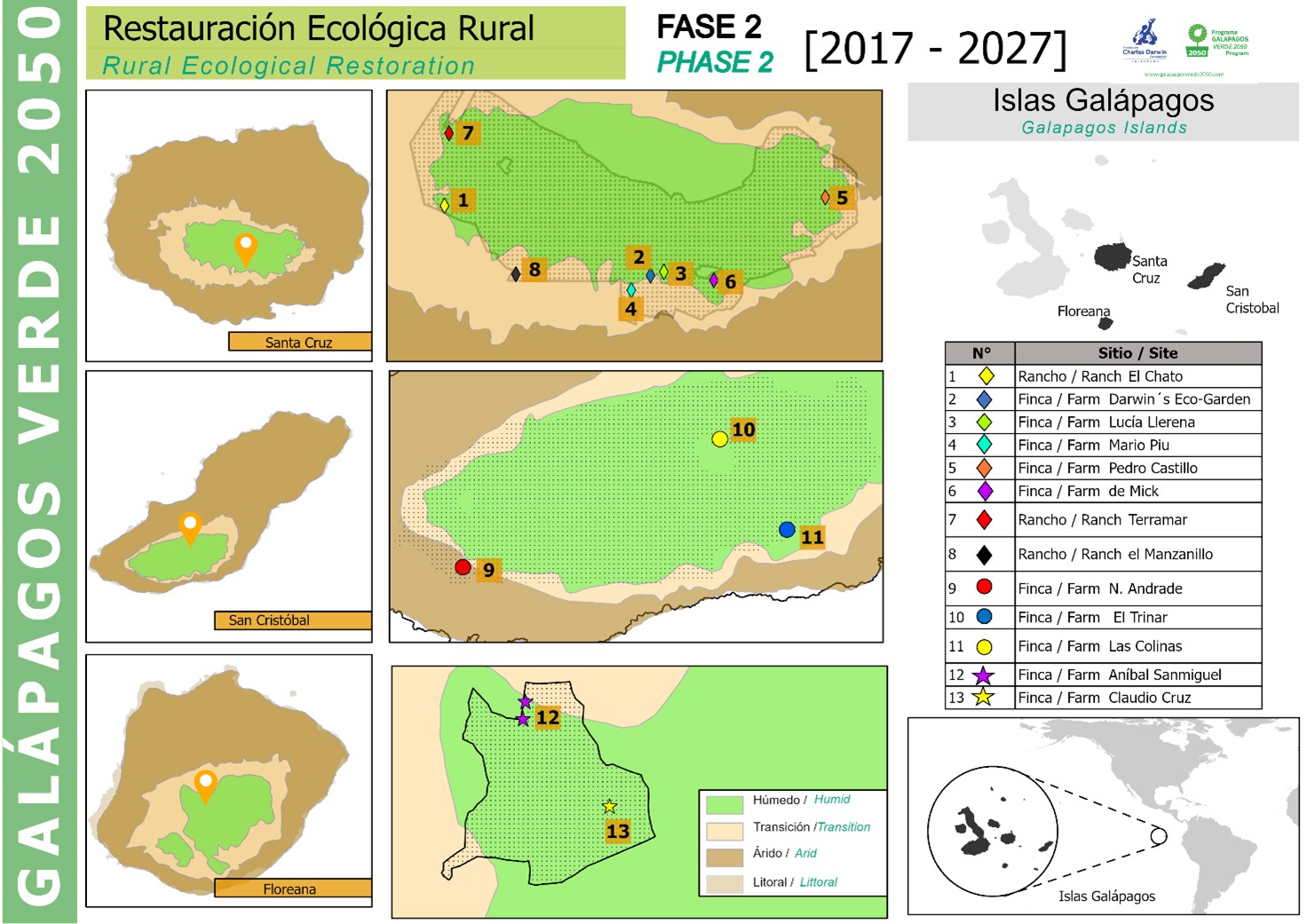
Map of study sites on three islands of the Galapagos archipelago.
Timeline
The GV2050 was born in 2013 as a single project with two components: ecological restoration and sustainable agriculture. Remaining with this organization until 2021, it takes the category of Program comprised of 7 different projects. The rural ecological restoration project began in 2014 on the island of Floreana and had two defined components: rural restoration and sustainable agriculture. Later, in 2017, work began on the island of Santa Cruz and San Cristóbal with the same components until 2021, which culminated with the objectives of the sustainable agriculture component.
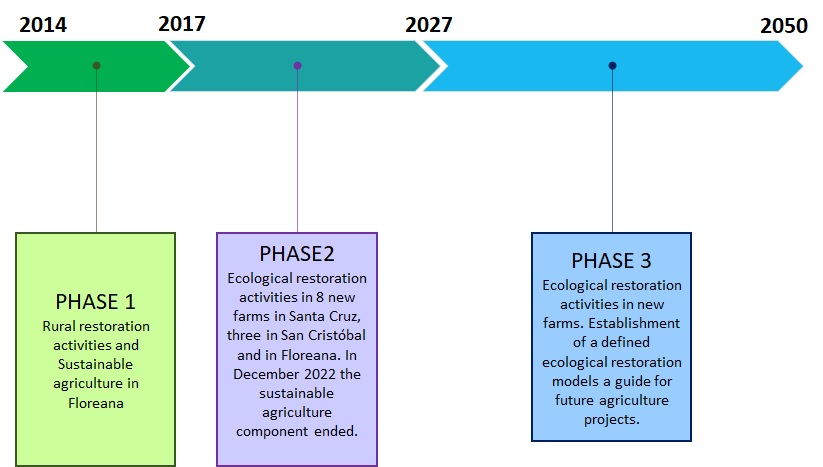
The Rural Ecological Restoration project phases in Floreana, San Cristóbal and Santa Cruz.
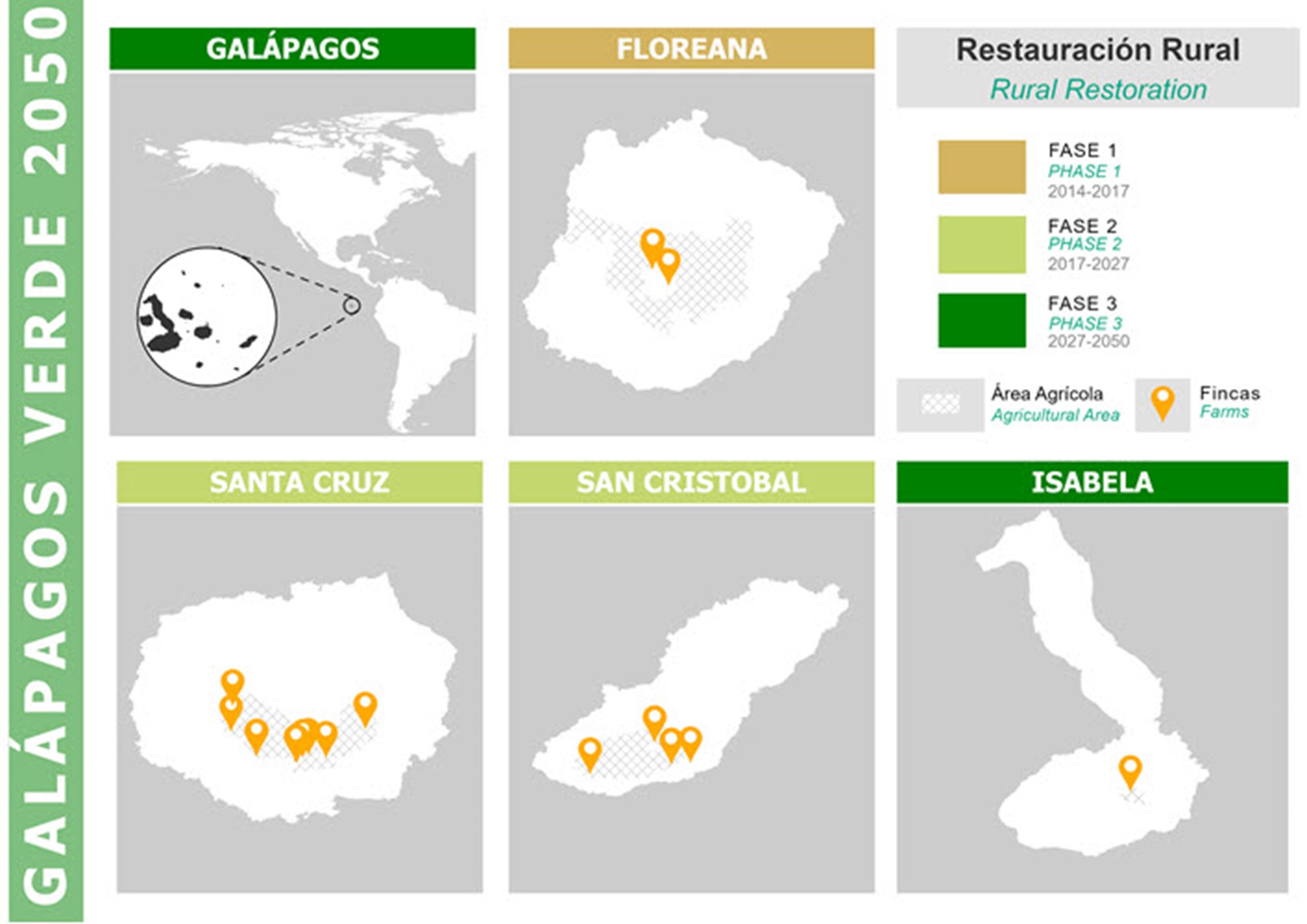
Map of the project phases.
Results obtained
From 2013 to 2021, the project was in the sustainable agriculture component. GV2050 worked on three properties, where we planted more than 700 plants of four commonly cultivated species: pepper (Capsicum annuum), watermelon (Citrullus lanatus), cucumber (Cucumis sativus) and tomato (Solanum lycopersicum). At the end of this first phase, in Floreana, more than 250 plants of 13 species were planted and reached an average of 45.1% survival.
Rural restoration efforts have been made on the farms of Claudio Cruz and Aníbal Sanmiguel, planting 389 individuals of 11 native and endemic species using different water-saving technologies to diversify current monocultures; these technologies are Hydrogel, Waterboxx®, Cocoon + Hydrogel and Waterboxx® + Hydrogel. Meanwhile, rural ecological restoration began in Santa Cruz on four local farms: Tantum Galápagos, Vicente Castillo, Mick Allen, and the Rancho El Chato II ecotourism farm and turtle reserve.
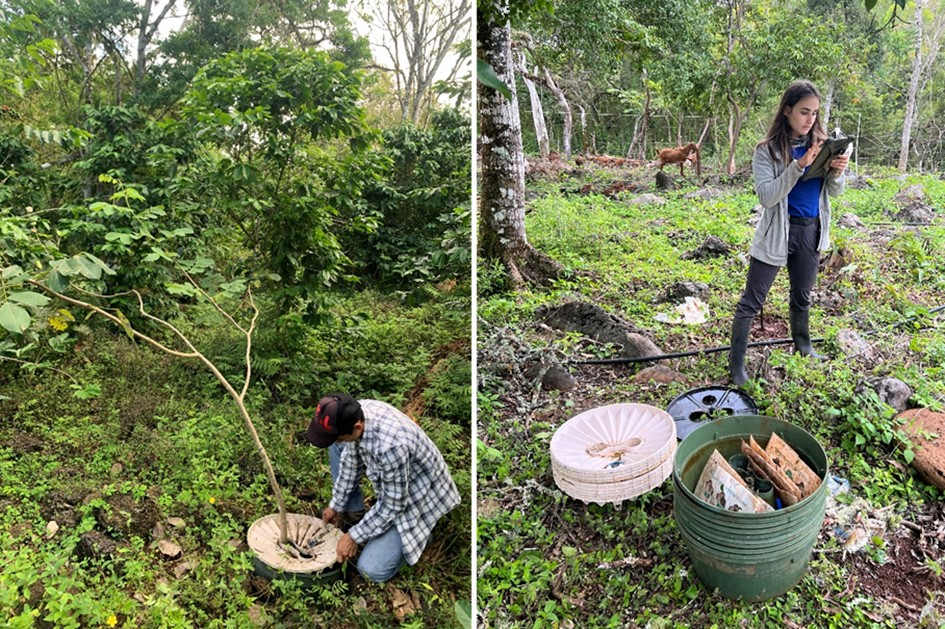
Rural ecological restoration at Finca Tatum Galapagos on Santa Cruz Island (left) and Finca Nicolas Andrade, San Cristóbal (right).
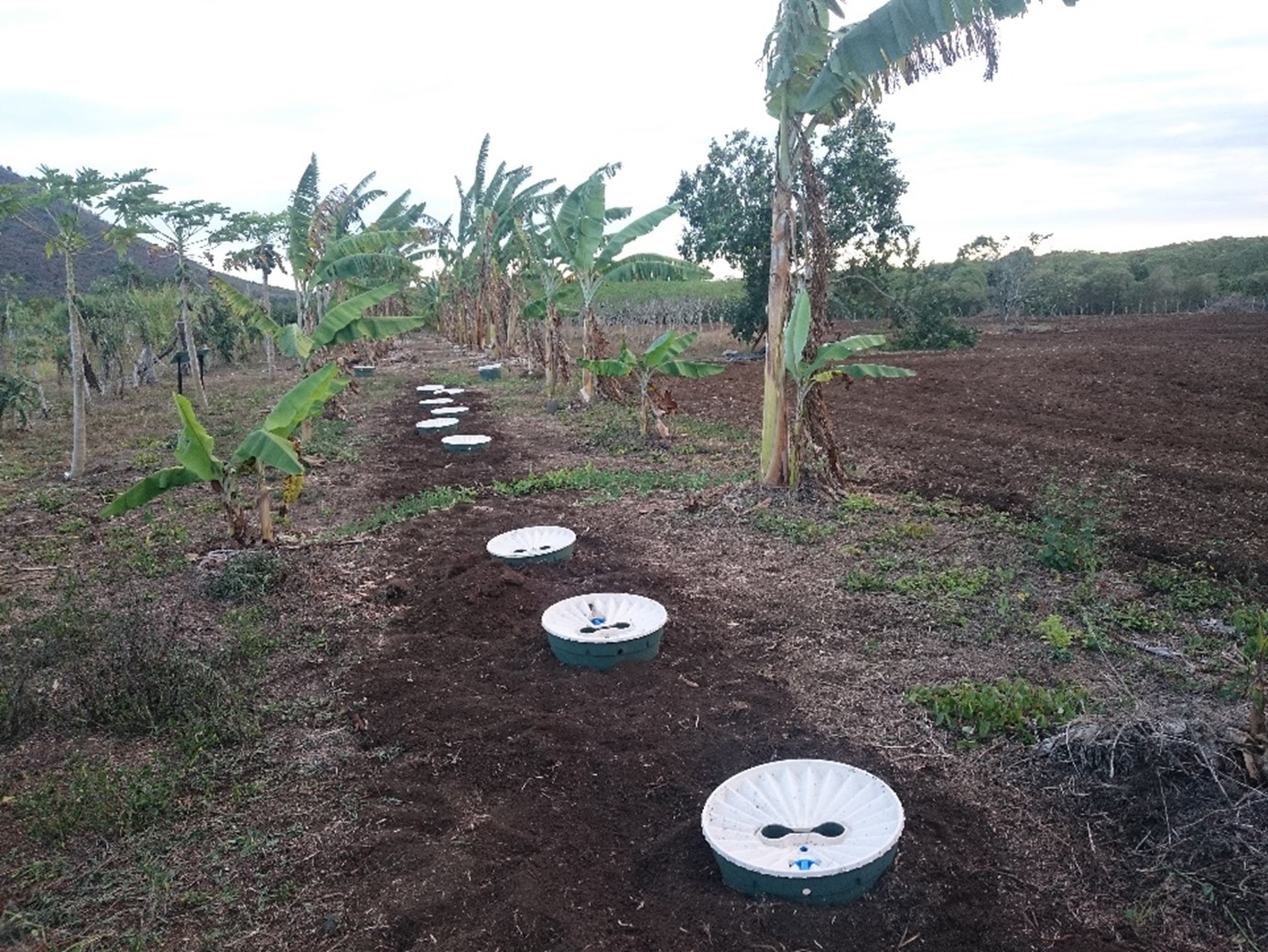
Rural ecological restoration at Finca Claudio Cruz, Floreana.
On the other hand, the species Scalesia pedunculata is being specifically studied and it has been observed that it presents a survival rate of 78.54% in Santa Cruz, while in Floreana it is 40.97%. For this species, it is also intended to study the carbon fixation data in 279 individuals and, once they are available, preliminary results of the average carbon that agroforestry systems are fixing can be estimated.
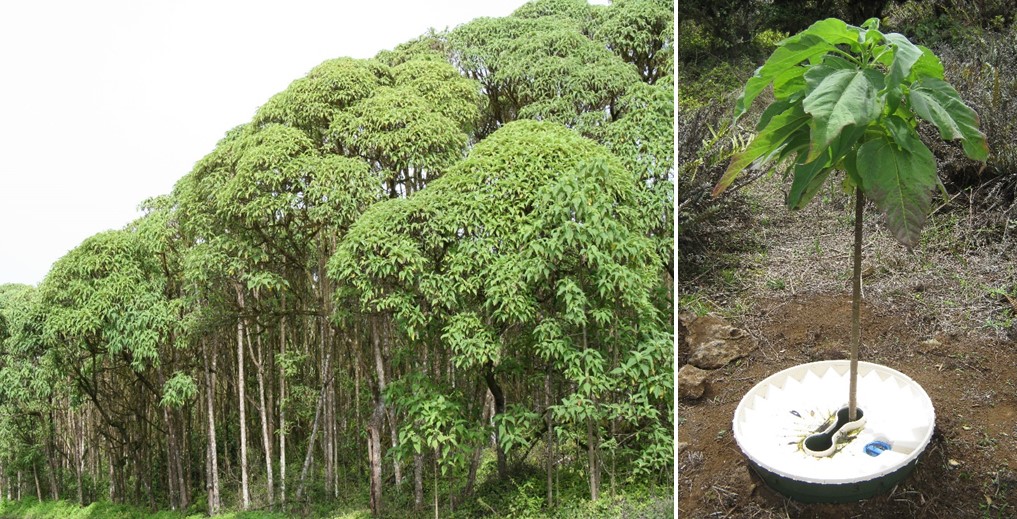
Mature individuals of Scalesia pedunculata (left) and immature individual growing with Groasis Waterboxx® technology (right).
Can you imagine how many plants we have planted in rural restoration?
Floreana Island
Since the efforts of GV2050 began in Floreana for rural restoration in 2014, 418 plants have been sown, of which 231 are still alive. This means that the endemic and native plants that have been sown have a 55% survival rate.

Representative graph of all the species planted in Floreana. In grey, all the planted ones. In green, the living species. Source: RestoR GV2050. Capture date: October 2022.
As already mentioned, the crops are accompanied by water-saving technologies. In the Floreana farms, the most effective technology was the Waterboxx®, with a 25% survival rate at month 96 after planting. After this, the most effective treatment was the control, that is, those plants that do not use any water-saving technology, since they present a 20% survival in month 96 after planting. Then there are the other treatments: Waterboxx® + Hydrogel, Cocoon + Hydrogel and Hydrogel, with 35%, 25% and 15% survival at month 40 after planting, approximately.
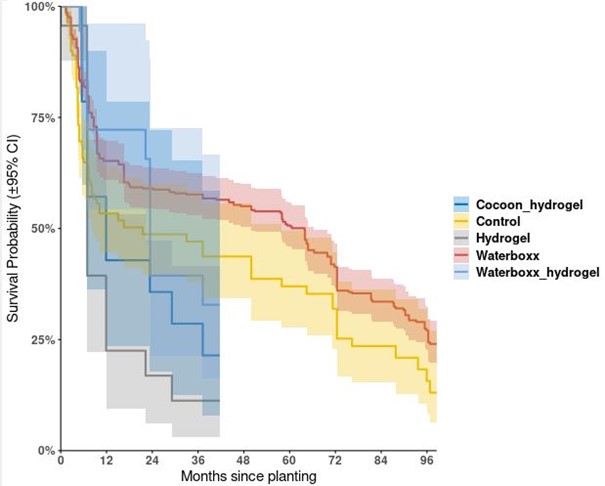
Representative graph of the survival percentage according to the different water-saving technologies in Floreana.
Based on one-year predictions, the best results indicate that Groasis Waterboxx® was the most efficient technology, with approximately 60% survival and the smallest error bar. Cocoon + Hydrogel and only Cocoon proved to be the least efficient technologies since they have the widest error bars.
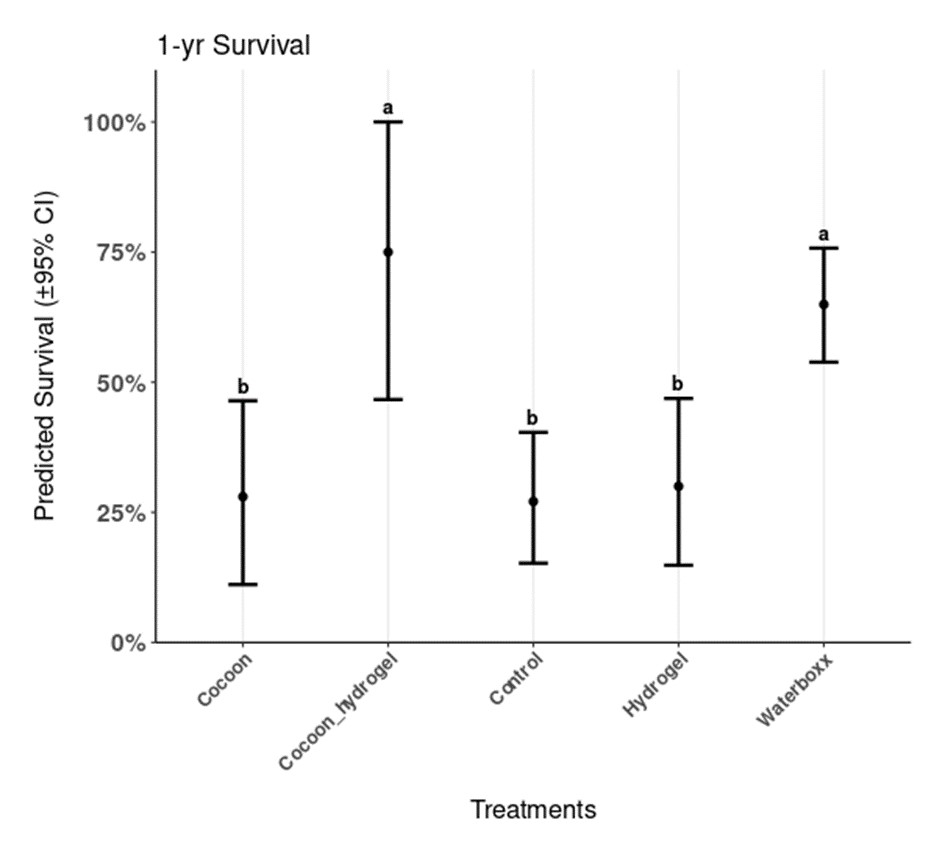
Representative graph of the expected survival percentage according to the water-saving technology applied in San Cristóbal. Source: RestoR GV2050.
¿Would you like to know more about rural ecological restoration?
Galapagos Verde 2050: Recovering native and endemic species at ranches.
Rural Ecological restoration: In Santa Cruz, San Cristobal and Floreana Islands.
You can also find our news at social networks
Facebook post about rural ecological restoration in Floreana
Facebook post about rural ecological restoration video
Facebook post about sustainable agriculture in Santa Cruz
Facebook post on sustainable agriculture in San Cristóbal
You can download more information from some of our publications
Download book "Green Galapagos 2050 (Volume 1)"
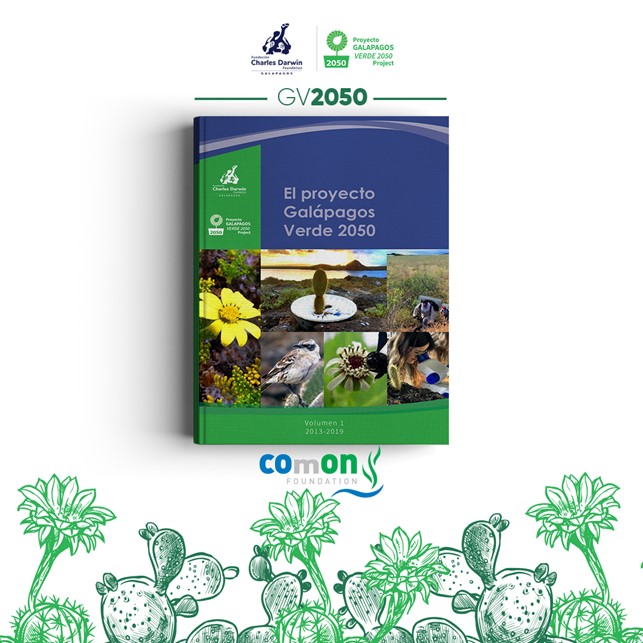
Download triptych leaflet about the work of the GV2050

References
Gerzabek, M. H., Bajraktarevic, A., Keiblinger, K., Mentler, A., Rechberger, M., Tintner, J., Wriessnig, K., Gartner, M., Valenzuela, X. S., Troya, A., Couenberg, P. M., Jäger, H., Carrión, J. E., Zehetner, F., Gerzabek, M. H., Bajraktarevic, A., Keiblinger, K., Mentler, A., Rechberger, M., … Zehetner, F. (2019). Agriculture changes soil properties on the Galápagos Islands – two case studies. Soil Research, 57(3), 201–214. https://doi.org/10.1071/SR18331
Linsley, E. G., Rick, C. M., & Stephens, S. G. (1966). Observations on the flora relationships of the Galapagos carpenter bee. The Pan Pacific Entomologist, 42, 1–18.
Traveset, A., Olesen, J. M., Nogales, M., Vargas, P., Jaramillo, P., Antolín, E., Trigo, M. M., & Heleno, R. (2015). Bird–flower visitation networks in the Galápagos unveil a widespread interaction release. Nature Communications 2015 6:1, 6(1), 1–6. https://doi.org/10.1038/ncomms7376
Inter-institutional collaborations
Galapagos National Park Directorate (DPNG), Galapagos Conservancy, Agency for the Regulation and Control of Biosafety and Quarantine for Galapagos (ABG).
Our main donor
COMON Foundation

 Donors:
Donors:

Partners:




